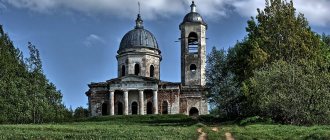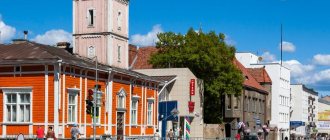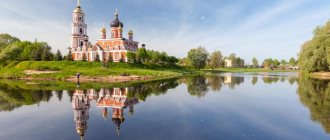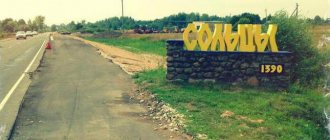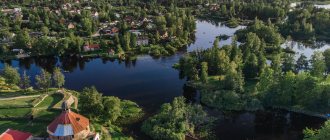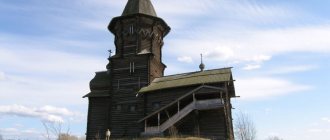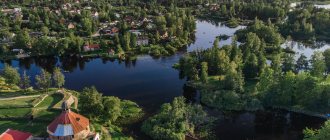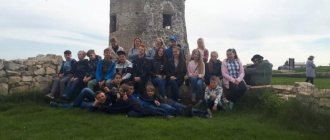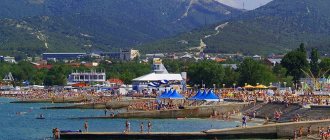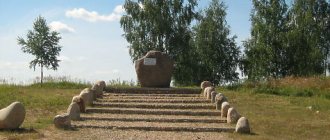History of Okulovka:
On January 12, 1965, by Decree of the Presidium of the Supreme Soviet of the RSFSR, a new city was approved - Okulovka.
The city was formed as a result of the formal administrative merger of the villages of Parakhino and Okulovka. About the emergence of Okulovka Historical and demographic review. On January 12, 1965, by Decree of the Presidium of the Supreme Soviet of the RSFSR, a new city was approved - Okulovka. The city was formed as a result of the formal administrative merger of the villages of Parakhino and Okulovka. Old-timers still remember that Parakhino, in turn, was formed by the merger of the villages of Poddubye, Novinka, Elagino, Parakhino itself, Obrechye, Shurkino, Kamoka, Soinka, and in Okulovka parts were known - Kuzminka, Shemilovka, Caucasus, Ural, Boloto, etc. This article is an attempt to penetrate into the history of the emergence and gradual development of Okulovka.
Archaeologists can look deeply into history. They discovered a Neolithic human site near Okulovka on the shore of Lake Zaozerye. That is, people lived here more than 5 thousand years ago. The large burial mound of the 7th-10th centuries is well preserved on the shore of Lake Okulovskoye. Mounds from the 6th to 9th centuries are preserved in the forest near Kamoka. There are many traces of human habitation (mounds, hills, zhalniki, settlements) in the Kulotino-Polishch area. All this indicates that the area of the present city of Okulovka, and in particular the Peretna River and Lake Zaozerye, have long been well inhabited by humans. As a result of scientific excavations carried out by N.K. Roerich, S.N. Orlov, V.Ya. Konetsky and other archaeologists found shards of molded ceramics and later ceramics made using a potter's wheel, remains of iron production based on swamp ore reserves, objects indicating farming, cattle breeding, and trade. The replacement of settlements of Finno-Ugric tribes with Slavic settlements is traced. Since those distant times, some of the geographical names have come down to us.
The very first written evidence about the villages of our region is available in the Census quitrent book of Derevskaya Pyatina, compiled at the end of the 15th century (around 1495) for the purpose of calculating quitrent. The lands on which our city arose then belonged to the Polish churchyard of Derevskaya Pyatina.
In the long list of villages of this churchyard, there are many that still exist today: the village and churchyard of Polishcha with a church, Makhnovo, Moshnikovo, Khorino, Dernik, Korzhaevo, the village on Krutets, Tereblen, Vatagino, Druchno, Zuevo, the village of Berezovets, Korytnitsa, Manuylovo, the village on the lake Peretno with the church and others.
And here is a particularly important passage from this document: “In the Polish churchyard of the Grand Duke of the village of Fedorovskie, Telyatev followed Rodivon, Ivan’s son Zeleny, to the estate.
<…> D. Obreche: door. Rodivonov man Ivashko, dv. Matfeiko, they sow 5 boxes of rust, and mow 30 kopecks of hay, 2 crops; the old income is half-4 money, and from the bread a quarter, cheese, a handful of logs, the rest of the hay; the housekeeper half a rosary of rye, half a rosary of oats, cheese, a spatula, a handful of luna. D. Obrechye: door. Konanko Fomkin and Sysoiko, dv. Ivashko Danilkov, they sow half-7 boxes of rye, and they mow half-30 kopecks of hay, 3 boxes; old income 7 money, and from bread a quarter, cheese, a handful of luna, a piece of hay; the housekeeper half a rosary of rust, half a rosary of oats, cheese, a spatula, a handful of lnu.<…> D. Obrechye: door. Rodivonov person Demidko, dv. Fedko Sedelnik, they are sowing rust <…>. D. Yurkovo: two. Trofimko and Ogafonik Yurkovs <…>. D.Donzo: two. Yakimko Senkin, d. Nefedko Nesterikov<…>. D. Ostashovo: dv. Ondrejka Vlaskov <…> no income: the village is new. <…> And Rodivon has a third of the land in Lake Khvoshchne, and a quarter in the other lake Khvoshchne.”
As you can see, the area where the Peretna River flows from Lake Zaozerye, now called Obrechye, was densely populated already in the 15th century. Okulovskoye Lake (then Lake Khvoshch, as recalled by the Khvoshchenka River flowing from the lake) and Yurkovo Lake and the area downstream of the Peretna River were developed. Only the lands there belonged not to Rodion Ivanovich Zeleny, but to Ivan Vasilyevich Zakharyich-Lyatsky.
In confirmation, let us quote once again the quitrent book of 1495: “In the Polish churchyard of the volost of Ivan, Vasilyev’s son Zakharyich Lyattsk, which was given to his father as a dowry by Orina, Vasilyev’s wife Mikiforov. <…> D. Porakhino: door. Fedko Stepankov, door. Vasyuk Dorokhov, they sow half-2 boxes of rye, and mow 30 kopecks of hay, 2 crops; income 7 money, boxes of clear rye, half-2 boxes of oats, half a handful of hay; for the villager a rosary of rye, a rosary of oats, 2 cheeses, 2 spatulas, 2 handfuls of luna; for the housekeeper a rosary of rye, a rosary of oats, 2 cheeses, 2 spatulas, 2 handfuls of luna; I birich half a rosary of rye, half a rosary of oats. <…> And half of the land in the Peretna River is in Ivan’s stake.”
In addition to Porakhin, the village of Ukamok is named in the same volost. Wasn’t she where Kamoka is now - a section of the city of Okulovka with a hardware factory?
Now we are forced to miss three whole centuries in the history of the Okulov land due to the lack of archival materials and in the hope of someday filling this gap. These three centuries are full of such significant events as the campaigns against Novgorod by Ivan the Terrible, the Livonian War, the Polish-Swedish intervention, which led to a significant reduction in the rural population and required the resettlement of Karelians to the Novgorod region, the reforms of Peter I, the emergence of the cities of Krestsy, Valdai, Borovichi and the development of handicrafts , general land surveying and much more. The beginning of the 19th century was marked by the Patriotic War with the French.
All these events, one way or another, affected the life of the outback in the upper reaches of the Peretna River. Generations and owners changed, villages were born and died, but a truly revolutionary event for these places was the construction of the railway between St. Petersburg and Moscow in 1843-1851. The alienation of land for the construction of a road and the construction of a large railway station OKULOVSKAYA most radically redrew the map and way of life of these places.
Having appreciated the convenient location of the area near a large station, foreigners Ashton and Pasburg in 1856, near the village of Parakhina, four miles from the Okulovskaya station, founded a paper factory on their own land, which initially produced wrapping gray, blue sugar and white paper from rags and heating rope bast shoes.
With the abolition of serfdom in 1861, the outflow of peasants from the countryside to the railway and factory intensified.
A detailed picture of the settlement of people on the territory of modern Okulovka as of 1879 can be found in the List of populated places of Krestetsky district, published by the Novgorod Statistical Committee (Novg. 1884). In the Zaozerskaya volost of Krestetsky district the following settlements are listed, now included within the city limits:
Travel to the city of Okulovka. Few people know what beauties the Novgorod land conceals.
We were brought to Okulovka for an unusual reason. The fact is that my friend Artyom and I are big fans of railways. And we especially love small railway lines that branch off from major highways and go into the wilderness. For the sake of travel on such quiet small railway lines, we come up with different trips from time to time. Last year we went to Borovichi to get acquainted with the short line Borovichi - Uglovka, this year we decided to take a ride on another quiet line - Okulovka - Nebolchi. The train runs there only once a week, and on Tuesdays, which made it difficult to organize a trip, since it is a working day. For a long time I waited for both of us to be completely free on some Tuesday, and in August such an opportunity presented itself. A few more comrades were able to go with us, and so we hit the road. Naturally, since we ended up in Okulovka, we also got to know the city itself. And it turned out to be much more interesting than just a junction station from which a side track departs. First of all, it's cute and cozy. Secondly, the nature there is amazing. I was especially pleased with Okulovskoe Lake - large, with clear and clean water! And few people know these beautiful places, without even realizing what beauties the Novgorod land conceals... Therefore, I will introduce my readers to this Russian town, so that they, too, can someday take a walk here. Or at least get to know him through my photographs. Okulovka station. On the right is the main passage, the road from St. Petersburg to Moscow. In the center there is a path for electric trains. And on the left are the tracks for the very road adjacent to the main route along which trains from Okulovka go to Nebolchi. The photo shows a diesel locomotive with the only trailer that will go there. But you will read more about this in another article, where I will talk about our trip from Okulovka to Kulotino. And now about Okulovka itself, where we spent several hours after returning from Kulotin. It was a hot day and it was necessary to take a swim. Therefore, we went towards Lake Okulovskoye, where one of the local beaches is located. It was possible to go to the river, but as it passed through the city it could no longer be clean, so the lake was a more attractive option. Our path was blocked by a black cat, which had no intention of moving at all; in order to give way to someone, we had to go around it to the left. In general, there are a lot of cats in Okulovka, and that’s good! Wooden house with an apple tree. An incredible amount of apples. There are a lot of them here at every step. Civilization ended suddenly - just 15 minutes after we left the station. The houses and streets ended, wild fields began without a hint of the presence of people. It's awesome to live in a city where wildlife is so close to the city! In the summer the road pleases with flowers, there are plenty of them around. In general, where we walked can be called a road very conditionally. On the map it really looks like a road, but in reality everything that leads in different directions is just trampled grass. It is not recommended to walk here without a navigator if you are not local. Such roads may not appear on other maps. If you get to the lake, it will be through a long path that will lead to the far shore. And we took the shortest route, which took only half an hour. We spent the last five minutes walking through the forest. The forests here are quite as nice as ours on the Karelian Isthmus. And noble mushrooms are present in normal quantities. Here we found a white one right on the road. Before this, many mushrooms had already been collected in another Novgorod corner - Kulotin. We went out to Lake Okulovskoye. It turned out to be quite large. Immediately it started to drizzle, and we didn’t get any good photos because the camera fogged up and there was not enough lighting for the smartphone. But we tried to film it somehow to show you the beauty. On the map this place is marked as a beach. But the beach itself is a small entry into the water along the sand and a clearing next to it. Very modest. On the other hand, it is beautiful and cozy. On a Tuesday in the summer there is not a soul on the lake, and for a small company everything is perfect here. But I don’t know what it will be like on a weekend if a lot of locals come. That's the whole beach. I really like such places - nature is not spoiled, there is a lot of greenery, there is no garbage, there are no fire pits at every turn. And at the same time it is very pleasant to swim, because the bottom is sandy, smooth, there is no grass or stones. It’s simply a miracle that nature has been so well preserved near the city! Locals don’t spoil it, and strangers don’t come here to spoil it. And if anyone comes after reading my blog, it will be those who come for beauty, and they will not be able to disturb it. The lake is lucky - it is far from major roads, an evil kebab-maker in a car will not get here. Beauty! And all this is so close to the station, from the city! Incredible! Forest edge near the beach. I was also surprised to see large schools of fish swimming along the beach. They didn’t allow themselves to be photographed, but there were really a lot of them. This is what I managed to photograph - two roach, but in reality there were dozens of roach and perch. The lake is very fishy. The main advantage of the lake is very clean and transparent water! The same as in the best lakes of the Leningrad region! I didn’t expect to find such clear water in these parts; I thought there were lakes only with swampy water. To record the clarity of the water, we take a couple of underwater photos. And this is the author of the blog. Visibility underwater is excellent! The lake is magnificent! Let's go back. There's time to take a closer look at the houses. The main type of buildings are small wooden houses, next to which there is an area enclosed by a fence. Okulovka is very reminiscent of a village. It has been a rural settlement for almost its entire history; it received city status only in 1964. The population now is about 10 thousand people. On the fence, a cat is washing itself with an important air. Unfortunately, a significant part of the city's houses are boarded up. And many of them are already completely dead. When Okulovka became a city, 20 thousand people lived here, now the population is half that, and this process continues. Here, in one frame, there is both a dead house and an unfinished house. City intersection near the station. It should be noted that the initial gloomy impression of the dead houses quickly disappears, because the atmosphere in the city is somehow spiritual and peaceful. The people are all calm, smiling, willing to give advice if you don’t know something, and greet tourists warmly. We saw the same thing in other places in the Okulovsky district. No sadness is felt in them, they love their land, and they are not sad here. This sharply distinguishes the Novgorod region from the Pskov region, where even in the main city of the region everyone has melancholy and hopelessness on their faces. Everything I described above is expressed in the writing on the wall. For every dark night there is a bright day, it says here. This probably conveys what the residents of Okulovka live with. By the way, while walking around the city, I didn’t come across obscene words on the walls (take a walk in Luga in our region - you’ll see a three-letter word there many times a day), but I saw a lot of all sorts of philosophical statements, as well as quotes from poems by famous poets. And here they listen to Tupac Shakur, as can be seen in the same photo - and I also support this. There are no monuments to politicians, leaders, or generals on the main square, as is most often the case in many cities. Not a single monument to bloodsuckers. Everyone who stands here is a cultural or scientific figure. And that's great. This is my ideal - for monuments to stand just like this! The main character here, of course, is Miklouho-Maclay. The famous Russian ethnographer and traveler was born in Okulovka. There is a museum dedicated to him, and ethnography conferences are held here. Near the monument there is a park with benches where it is pleasant to sit and relax. There are no dead houses here anymore, everything is more or less alive and well-maintained. Again, I will note a feature of the Novgorod region, which I have been writing about for years: there is almost no garbage here, the streets are clean and tidy. And people are good-natured, even if they are drunk.
Large residential building near the station. Wood. There are few stone houses here. Here is one of the stone houses. Ancient, with unusual architecture. Pay attention to the unusual windows. The plaque reports that the Russian scientist Yuri Roerich, son of the artist Nicholas Roerich, was born in this house. He was also an ethnographer and traveler. Very close you can see a monument to the scientist. The square in front of the station. An old wooden house opposite the station. Alley along the railway. Everything is very beautiful and cozy. The old Okulovka station, unfortunately, has not survived; it was demolished several years ago, which was a great barbarity on the part of Russian Railways. At the station there is only this railway building. Okulovsky district is distinguished by great patriotism. At the station there is a stand listing the attractions, and there is a website on the Internet with their detailed descriptions. You won't find anything like this in many places. People here love their area very much and are in a hurry to tell everyone about it. I support them in this endeavor, so I will also write about their attractions. Near the station there is a monument to Viktor Tsoi, by which most people remember Okulovka. So, three monuments: one to an artist, two to scientists. And this is good! Why there is a monument to Tsoi, who is a St. Petersburg character, stands here, it is not very clear. There is a legend that once he was traveling somewhere through Okulovka. That's all. I think that the point is simply that here they love his work just as much as here in St. Petersburg. And this also speaks well about Okulovka. Russian rock is alive, hurray! Well, now let's go look at the ancient church located at the end of the square. This is the Church of Alexander Nevsky. It took us a while to figure out how to get past the fence that encloses the temple, but a local woman immediately rushed to tell us how to get around the fence. I repeat once again that the locals here are friendly and helpful. By the way, not far from the church there is a pie shop where you can find delicious and inexpensive pies. It is interesting that the temple began to be built in the name of St. Nicholas, but was eventually consecrated in honor of Prince Alexander Nevsky. Local merchant Ivan Zubov donated a significant amount for the construction of the temple. The temple was built in 1901, under Emperor Nicholas II. In 1937, Stalin began a real massacre among priests, exterminating almost all of the clergy in Russia. Temples were closed en masse throughout the country. This church was also closed. They made a cinema inside. The height of the bell tower is 12 fathoms, which in modern units of measurement would be 25.6 m. Therefore, it is clearly visible from afar. In 1993, the dilapidated temple was returned to believers. Gradually it regained its blooming appearance. Before the revolution, an almshouse was built near the temple, where a dozen and a half old women and old men lived out their lives and were cared for there. At that time, churches often engaged in charitable activities. Beautiful bell tower. Monument to the victims of political repression. In small towns, those killed by communist executioners are well remembered. And this memory should not disappear so that this never happens again. On the other hand, they remember the liquidators of the Chernobyl accident. Beautiful temple! I went to the station. I met only one worker inside, and he was sleeping with his head on his paw. There is no one at the frames at the entrance to the station building, and this makes me happy. At least here they don’t spoil people’s mood by simulating concerns about safety. The waiting room is small. But there is a coffee machine and toilets, so the station is comfortable. A year ago we were at a similar Uglovka station - it was just empty, no waiting room, no service, but there were guards. Here it's the other way around, and it's nice. Let's go to our train. We return to St. Petersburg by two different “Swallows” - one on the “Swallow” from Bologoe, the other on the Moscow one. On the way we make a stop in Malaya Vishera. And there I photograph the old station. There was once a similar one in Okulovka.
Original
Famous people who visited Okulovka
• L. N. Tolstoy visited the estate of his mother-in-law L. A. Bers • Yu. N. Roerich in 1879. He carried out excavations, the results and discoveries of which were included in the “Golden Fund” of the Imperial Russian Archaeological Society. • I. I. Levitan. The motives of Okulovskaya life were captured by him in the landscapes “The Last Rays of the Sun”, “Twilight”, “Haystacks. Twilight”, “Huts”, “Summer Evening”, “Lake (Rus)”. • N. A. Rimsky-Korsakov worked in 1901-1903. over the opera “Kashchei the Immortal” and “The Tale of the Invisible City of Kitezh and the Maiden Fevronia”. • S. V. Rachmaninov, composer. • O. F. Berggolts, poetess. Here she had the idea of writing the book “Day Stars”. The nature of the Okulovsky region became for her a visible image and symbol of the Motherland. • Poets M. Kuzmin, S. Auslender, N. S. Gumilyov loved to relax here. • Academician N. Zheleznyakov, the founder of the Timiryazev Academy, had an estate here. • V.V. Bianchi, writer who called the Okulovsky region “The Land of Divas.” In modern times, the city makes transfers from electric trains in St. Petersburg and Moscow directions, as a result of which “brawls often occur here with the participation of fans of the capital’s football clubs.” One of the largest incidents occurred in Okulovka in 1999. Then, in the riots organized by CSKA fans, several people were injured and material damage was caused to municipal property.
The city of Okulovka is the administrative center of the Okulovsky municipal district of the Novgorod region. Located on the Peretna . The city is located 150 km from Veliky Novgorod, 249 km from St. Petersburg and 400 km from Moscow. Railway station - Okulovka.
The area of the city is 2641.9 hectares. The population of the city in 2012 was 12,548 people.
The very first written evidence about the villages of the Okulovsky region is available in the Census quitrent book of Derevskaya Pyatina, compiled at the end of the 15th century (around 1495) for the purpose of calculating quitrent. The lands on which the settlement arose and its surroundings then belonged to the ancient Polishchensky churchyard of Derevskaya Pyatina. So, like Valdai, Okulovka has every opportunity to celebrate its 500th anniversary.
The roots of Okulovo names, as in many places, go back thousands of years. Okulovka and Kulotino have the root “kul” - in Russian “kul-kul” - a large bag, an impressive bundle. Hence “kurkul”, “kulak” - a wealthy owner, the Russian “kulovery” - schismatics. It turns out that the names of the villages Kulotino and Okulovka are essentially the same root words. Thus, Okulovka is the penultimate point for collecting quitrent, the final Kulotino, which means okulo (i.e., about). There is also a version that has documentary evidence that the Nikolaevsky railway station Okulovka at 229 versts is named the same as a small village - the village of Okulovka. As the ancient Russian name book explains, various nicknames were widespread in Rus'. They were often used to give names to populated areas, wastelands, farmsteads, and settlements. Perhaps Okulovka was named after the nickname of Okula, the first settler in this place.
The emergence in the past of the village of Okulovka , and now the city, dates back, according to local old-timers, to the time immediately following the construction of the Nikolaev railway, i.e. after 1851. Familiarization with the existing city plan confirms this information: the direction of the main streets exactly follows the direction of the railway line. Before the construction of the railway, on the site of the village there was only the estate of the landowner Sippel.
A village began to be built on the southern outskirts of the station, and its first inhabitants were 12 families of Arkhangelsk Pomors. Foreigners also appreciated the advantageous geographical location. Foreign investors willingly settled in the region. The Gora estate was furnished by the Duke of Leuchtenberg. I. Vakner built a modern mill near the village of Pochep.
In 1856, in the village of Parakhino, on his land four miles from the Okulovskaya station, industrialist V.I. Pasburg founded a stationery factory, which initially produced wrapping paper from rags and rope supports. A little later, at the confluence of the Khorenka and Peretna rivers, the Kulotinsky factory for the production of sack fabric, founded by professor of medicine N. Bardashevich, arose.
The station village of Okulovka began to grow rapidly. In the shortest possible time, a small brick factory, Resha, was built, employing 20 people. The depot with two registered locomotives went into operation. Eight landowners, five contractors, twenty merchants, five priests, and fifteen policemen built estates and houses in the village. A merchant club, a four-year railway school, a parochial school, and a commercial school appeared (1910).
2 churches of St. Nicholas the Wonderworker (1901) and a wooden Church of the Virgin Mary , transported from the village of Mshentsy, were built, an almshouse and a Peasant's House were erected. A small zemstvo hospital with one doctor was also built.
Okulovka and the area were not captured by the enemy, but for more than two years they experienced all the hardships of front-line difficulties. Hard work almost around the clock, frequent bombings and reconstruction work.
In 1952, on the basis of the lower wood-pulp plant in Kamok, the construction of the Kamok Furniture Accessories Plant began. Agriculture is also developing successfully. Civil construction was carried out - multi-storey buildings appeared in Okulovka; a House of Culture was built, a paper mill with an auditorium for 780 seats, a club named after. Dzerzhinsky - 250 seats, House of Pioneers, 5 libraries, 2 stadiums. The city's population had 2 clinics and 2 hospitals, a railway dispensary; 3 health centers, 2 pharmacies.
By a decree of the Presidium of the Supreme Soviet of the RSFSR dated January 12, 1965, Okulovka was given the status of a city; it was formed as a result of the formal administrative merger of the villages of Parakhino-Poddubye and Okulovka-1.
In 1996, a monument to N. N. Miklouho-Maclay and an exhibition in the local history museum .
2004 In September, the passenger part of the new railway station came into operation. Okulovka.
The administrative building on Oktyabrskaya Street was reconstructed. The largest recreation center for youth is opened there - the Relax restaurant, a bank, a chain of stores, etc.
Some of the city's attractions include:
1. Railway station complex
- station building
— depot building 1850. Owned by the Oktyabrskaya Railway State Enterprise and used as a station and depot, the condition is emergency and unsatisfactory
2. Hospital building : XIX centuries. Owned by the Central District Hospital, clinic at the address - Okulovka, st. Kalinina, 62. Condition is unsatisfactory
3. Commercial school building . N. Nikolaev, a hero of the anti-fascist underground in 1917 and 1930s, studied here. Belongs to the Central Bank State Administration for the Novgorod Region, Sberbank, Okulovka, st. Kirova, 9, Condition - satisfactory
4. House of I. Soin. End of the 19th century. Belongs to JSC "Vesna", not used, emergency condition, Okulovka, st. Lenina, 31
5. Zolotarev’s House End of the 19th century. Belongs to the Okulovsky branch of Novgorodtelecom, telegraph, unsatisfactory condition. G. Okulovka, st. Lenina 32
6. Church of Alexander Nevsky 1900 Novgorod Diocesan Administration, by appointment, satisfactory. G. Okulovka, st. Lenina 33
7. Almshouse building, 1900. Novgorod Diocesan Administration, parochial school, satisfactory. G. Okulovka, st. Lenina 34
8. Merchant club building. End of the 19th century. Committee for Youth Affairs, Culture and Sports, Library and House of Culture, G. Okulovka, st. Lenina 51
9. Stationery factory : 1908 JSC “Okulovsky wallet”, Okulovka, Parakhino village, production premises
9.1 Main building 1908, 1923 JSC “Okulovsky wallet”, Okulovka, Parakhino village, production premises
9.2 Mechanical workshop 1927, XX century, JSC “Okulovsky wallet”, Okulovka, Parakhino village, production premises
9.3 Warehouse 1930, 1952 JSC “Okulovsky wallet”, Okulovka, Parakhino village, production premises
10 F. Shan's estate 2nd floor. XIX century District administration, building management No. 1. Unsatisfactory. G. Okulovka, st. Soviet
— Manor house Housing. Unsatisfactory
— Regularly landscaped park (2 hectares). Unsatisfactory.
11 The building of the surgical building of the regional hospital , founded by the surgeon V. Besser (1889-1956) 1856, 1929 Okulovskaya Central District Hospital, surgical department of the Central District Hospital, satisfactory. G. Okulovka, st. Kalinina, 125
12 Cemetery of Soviet soldiers 1942 Administration of the Okulovsky district. Burial, satisfactory. G. Okulovka, st. Kalinina
13 Cemetery of participants in the civil war and Soviet party activists of 1920, 1939. Administration of Okulovsky district. Burial, satisfactory. G. Okulovka, st. Kalyaeva, communist cemetery
14. Cemetery of Soviet soldiers, 1943. Administration of the Okulovsky district. Burial, satisfactory. G. Okulovka, st. Kalyaeva, communist cemetery
15. Building. In which the elections of the Council of Workers', Soldiers' and Peasants' Deputies of 1918-1924 took place. House management No. 1, housing, satisfactory, Okulovka. St. Lenina, 28
16 Cemetery of Soviet soldiers 1941-1944 Administration of Okulovsky district. Burial, satisfactory. G. Okulovka, st. Lenin at the association "Robok" DRL
17 Mass grave of Soviet soldiers 1941-1944. Administration of Okulovsky district. Burial, satisfactory. G. Okulovka, st. Lenin. Civil (old) cemetery
18. Mass grave of Soviet soldiers 1941-1944. Administration of Okulovsky district. Burial, satisfactory. G. Okulovka, st. Lenin. Civil (old) cemetery
19. The house in which the hero of the anti-fascist underground N. Nikolaev (1918-1942) lived, lived in 1930-1939. Private ownership, housing, satisfactory. G. Okulovka, st. N. Nikolaeva, 9
20 The building in which the first Council of Workers' and Soldiers' Deputies of the Zaozersk volost was located, 1917. House management No. 1, housing, satisfactory. G. Okulovka, st. Novgorodskaya, 10
21 Grave of I. Tolstopyaty, workers' correspondent of the provincial newspaper "Zvezda", killed by enemies of Soviet power 1925 JSC "Bumazhnik", burial, unsatisfactory, Okulovka, st. Oktyabrskaya
22 The building of the school where the hero of the Second World War, pilot D. Parfenov (1919-1941) studied, 1930s RONO, school. Satisfactory, Okulovka, st. Parfenova, 32
23 Cemetery of Soviet soldiers 1941-1944 Administration of Okulovsky district. Burial, satisfactory. Okulovka, civil cemetery (new)
Okulovsky District Municipal Museum of Local Lore named after. N.N. Miklouho-Maclay is located in Okulovka , st. Lenina, 50. The museum is open daily from 10.00 to 17.00, except Sunday and Monday.
On the eastern side of the city there is a protected natural landscape and a lake. Okulovskoe .
Telephone code: +7 81657
City and district website: www.okulovka.com
State Enterprise Administration website: www.okulovka-adm.ru


